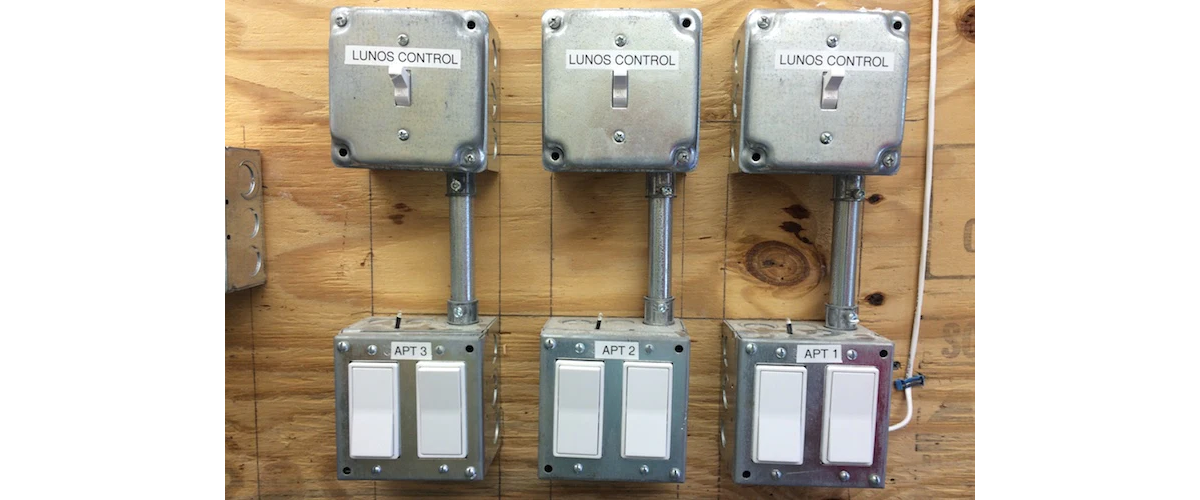The Presentation

475 gave a presentation on minimizing mold risk in high-performance buildings at a Maryland Affordable Housing Coalition event in Baltimore recently. In the audience were a number of affordable housing developers. During the talk we discussed the importance of airtightness, thermal-bridge-free construction, and good ventilation. The response from the housing developers, who were building more airtight with distributed ventilation systems, was interesting. Common statements included:
The occupants are not happy if they don't have control of the ventilation system.
It's not difficult for the occupants to confuse control settings, resulting in unintended operation modes.
Sometimes the occupants will shut off the ventilation system to try and save money on their electric bill.
In their quest to provide quality housing, the frustration was palpable. And it was obvious that while we may largely control airtightness and thermal bridges during construction - it's the ventilation system where things too often fall short. There seemed to be no clear answers.
The Problem
Back at the 475 HQ we thought more about the problem:
As multifamily building owners tackle high performance construction and codes mandating blower door tested airtightness, the risk of occupant dissatisfaction appears to be on the rise. Turns out many residents are uncomfortable with change. Who knew! And living in a high performance building - with thermal comfort and continuous ventilation - can challenge old habits and perceptions.
Those more adaptable will find the changes liberating. But those nervous about change may feel trapped - and occupants become unhappy because either they can't control the ventilation or the controls are too complex. The frustrated occupant may also simply decide to turn off the ventilation system altogether in an attempt to save money.
And if the ventilation isn't running or isn't running properly, poor indoor air quality and mold damages can quickly result. In lower income and elderly housing these potential issues are often exacerbated.
And it all seemed to boil down to a fundamental question heard back in Baltimore:
How can we provide foolproof ventilation, in these high-performance buildings, that ensures high quality indoor air, prevents mold growth and absolutely minimizes occupant complaints?
The Solution Resolves a Contradiction
So we need to figure a way to give occupants control of part of the ventilation but not of all the ventilation. These contradictory needs, we realized, can be addressed with a hybrid system which incorporates both centrally controlled continuous general ventilation AND occupant controlled bathroom intermittent ventilation.
There are two basic strategies at work:
- Provide a minimum underlying ventilation baseline: with continuous operation and no occupant controls.
- Give occupants control: control on intermittent ventilation that is familiar and understandable.
We'd Done It Before!
And with that realization it was deja vu all over again: as we'd done just this at The Residences at Melpet Farm, a 27 unit affordable housing development. Located on Cape Cod and overseen by Preservation of Affordable Housing, it was built to an airtightness of 1.0 ACH50. They chose a hybrid system out of concern for minimal space for ductwork and cost constraints - but the dual functionality was also a recognized benefit.
At Melpet Farm, the Lunos e2 ductless system offered a simple and flexible way to supply the underlying ventilation baseline. The through-wall units operate continuously at a low volume - providing quiet and unobtrusive fresh air with 90% heat recovery. Generally a Lunos fan unit is located in each bedroom and living space to ensure complete mixing and high indoor air quality. And because they are ductless units construction coordination and execution is simplified. The controls for these apartments were placed in a central utility closet outside of the units. Only the property manager controls their operation.
But then familiar bathroom exhaust fans were also provided - controlled by a light switch – so they would only be used when a bathroom was occupied assuring that this hybrid Lunos system works as close to the optimal 91% efficiency as possible. Stove exhausts were also provided in these units.
A New & Improved Normal
With such configurations occupants can happily continue with their normal habits AND the building management can confidently provide basic protection against moisture damages to its property.
Related Blog Posts:
- The Lunos e2 Primer
- Healthy Indoor Air Quality Confirmed with LUNOS e2: Monitoring Shows HRV Does The Job At Melpet Farm



 Melpet Farms affordable housing located on Cape Cod, used a hybrid approach to providing cost effective and simple high performance ventilation.
Melpet Farms affordable housing located on Cape Cod, used a hybrid approach to providing cost effective and simple high performance ventilation.
 Plan of three apartments shows Lunos e2 through-wall units in each living space (blue rectangles), with intermittent bath exhausts (red squares), and stove exhausts (red rectangles).
Plan of three apartments shows Lunos e2 through-wall units in each living space (blue rectangles), with intermittent bath exhausts (red squares), and stove exhausts (red rectangles).
 Lunos e2 fan unit tube installed during construction.
Lunos e2 fan unit tube installed during construction.
 Lunos e2 unit discreetly located on exterior walls.
Lunos e2 unit discreetly located on exterior walls.
 Continuous operation per design specifications is assured by placing control switches of the Lunos e2 units in a common utility closet - out of reach of the occupants.
Continuous operation per design specifications is assured by placing control switches of the Lunos e2 units in a common utility closet - out of reach of the occupants.
